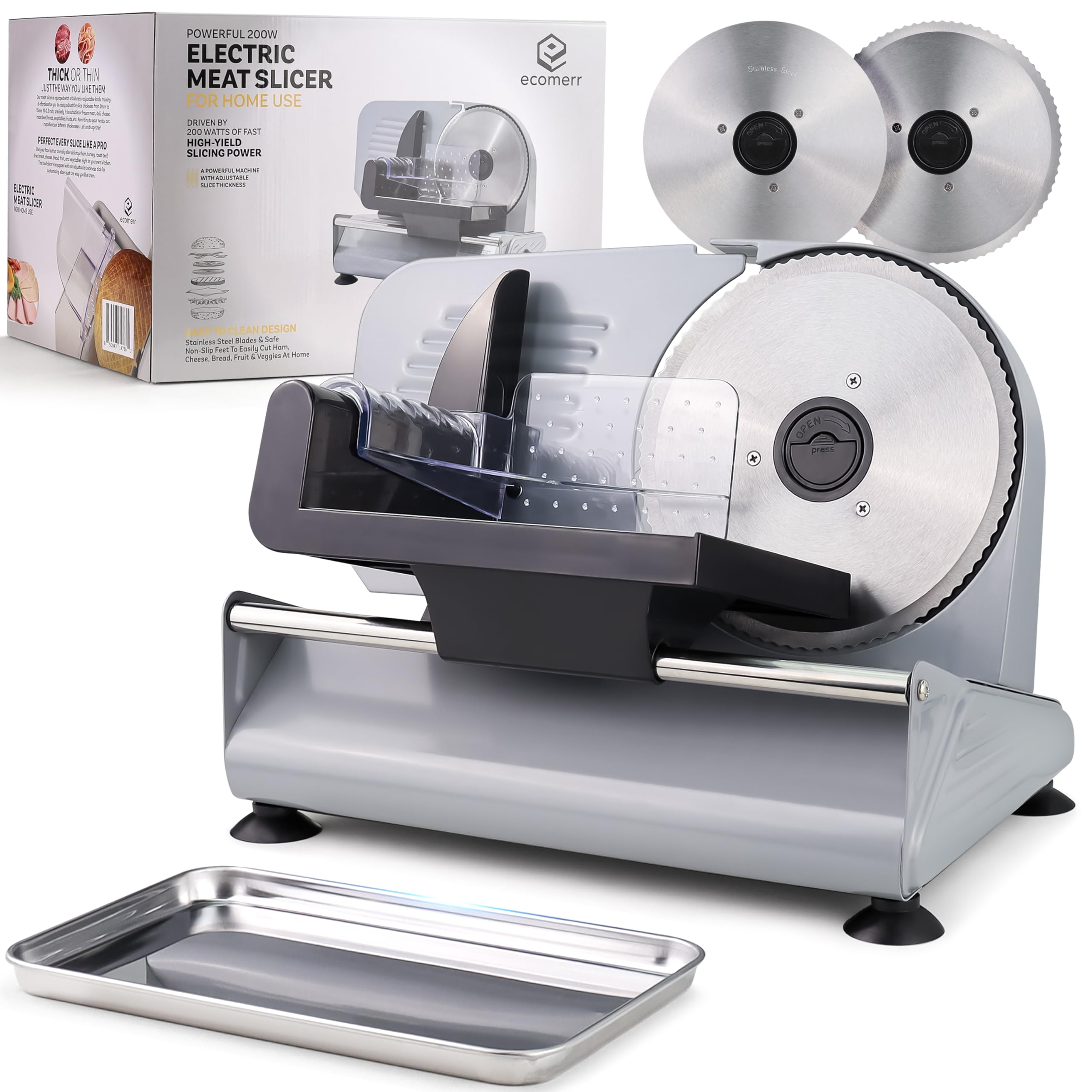9 Best Meat Slicers for Home and Professional Use: Detailed Reviews and Safety Tips
Are you tired of uneven slices and struggling with your kitchen knife every time you want perfectly sliced meat? A high-quality meat slicer can transform your culinary experience, making meal prep faster and more efficient. Whether you’re a home cook or a professional chef, the right meat slicer can save you time and effort, ensuring consistent results every time.
But with so many options on the market, how do you choose the best one for your needs? We’ve done the research for you and compiled a list of the 9 best meat slicers available today. From powerful electric models to compact manual options, there’s something here for every kitchen and budget. Dive in and discover which meat slicer will make your cooking adventures easier and more enjoyable.
Types of Meat Slicers
Understanding the different types of meat slicers is essential to finding the perfect model for your needs. Here, we’ll break down the three primary types for you.
Manual Meat Slicers
Manual meat slicers require you to move the product across the blade by hand. They’re perfect if you prefer control over each slice and have a lower volume of slicing tasks. These slicers are generally more affordable and don’t need electricity, making them a great option for small kitchens or occasional use. They’re also easier to clean due to their simple design.
Electric Meat Slicers
Electric meat slicers use a motor to spin the blade, allowing you to slice meat with minimal effort. Ideal for regular use, these slicers offer consistent slices and can handle a higher volume of products. They’re perfect for home cooks and small businesses needing efficiency and speed. However, electric models are typically more expensive and require regular maintenance.
Automatic Meat Slicers
Automatic meat slicers are the ultimate in convenience and efficiency. These models can continuously slice meat without manual intervention, making them suitable for commercial settings with high slicing demands. They offer programmable settings, allowing you to achieve precise slices every time. While they come with a higher price tag, their productivity and automation can save time and labor costs in the long run.
Factors to Consider When Choosing a Meat Slicer
Selecting the perfect meat slicer can be daunting. Consider these key factors to make an informed decision tailored to your needs.
Blade Size and Material
Choose a blade size that matches the type of food you’ll be slicing. Smaller blades (7-9 inches) are ideal for home use, handling meats, cheeses, and vegetables. Larger blades (10-14 inches) suit commercial needs, effortlessly slicing tougher meats. Opt for stainless steel blades for durability and ease of maintenance.
Power and Performance
Evaluate the slicer’s motor power. For home use, 130-250 watts is sufficient. Commercial environments benefit from 320-420 watts for continuous, efficient slicing. Look for adjustable slicing thickness to suit various food preparations.
Safety Features
Prioritize safety features to prevent accidents. Blade guards protect your hands from cuts and injuries. Non-slip feet keep the slicer stable during operation. Emergency shut-off buttons offer an immediate stop in case of malfunctions.
Ease of Cleaning
Pick a meat slicer designed for easy cleaning. Removable blades and components save time and effort, ensuring hygiene. Models with seamless design reduce food buildup, making cleaning more efficient and thorough.
Top 9 Meat Slicers on the Market
Here’s a comprehensive look at the best meat slicers available, catering to different needs and preferences.
1. Brand A Model X – Best for Heavy-Duty Use
Brand A Model X shines in heavy-duty use. Its robust motor can easily handle large chunks of meat and extended periods of slicing. This slicer is perfect for commercial kitchens or large family gatherings. You’ll appreciate the precision and durability provided by its stainless steel blade.
2. Brand B Model Y – Best Budget-Friendly Option
Brand B Model Y offers excellent performance without breaking the bank. Despite its lower price point, it doesn’t compromise on essential features. The adjustable thickness settings and ease of cleaning make it an excellent choice for occasional home use.
3. Brand C Model Z – Best for Deli-Like Precision
Brand C Model Z is designed for deli-like precision. It features a high-quality blade that ensures ultra-thin, consistent slices, making it ideal for preparing charcuterie at home. The machine’s smooth operation and ergonomic design make slicing effortless.
4. Brand D Model W – Best for Low Maintenance
Brand D Model W excels in low maintenance. The slicer’s parts are easy to disassemble and clean, saving you time and effort. Its non-slip feet and safety guard further enhance your user experience, making it suitable for those who prioritize hassle-free maintenance.
5. Brand E Model V – Best for Versatility
Brand E Model V stands out for versatility. It can slice a variety of food items from meats to cheeses and vegetables. The adjustable blade and powerful motor allow you to switch between different slicing tasks seamlessly, making it indispensable in the kitchen.
6. Brand F Model U – Best for Small Businesses
Brand F Model U is perfect for small businesses. It combines high performance with durability, ensuring it can withstand frequent use. The slicer’s powerful motor and precision blade make it ideal for delis, restaurants, or butcher shops looking for reliable equipment.
7. Brand G Model T – Best for Home Use
Brand G Model T is tailored for home use. It strikes the perfect balance between simplicity and functionality, making it easy for anyone to use. Its compact design doesn’t take up much counter space while still providing ample power for regular meal prep.
8. Brand H Model S – Best Compact Design
Brand H Model S is known for its compact design. This space-saving model still packs in powerful features, making it suitable for small kitchens. Despite its size, it doesn’t compromise on performance, making it a handy tool for those with limited space.
9. Brand I Model R – Best for Safety Features
Brand I Model R prioritizes safety features. Its built-in blade guard, non-slip feet, and child lock ensure that you can slice safely, making it ideal for households with kids. The focus on safety doesn’t detract from its slicing efficiency, providing peace of mind along with excellent performance.
Buying Guide for Meat Slicers
Choosing the Right Size
Selecting the right blade size is crucial for your slicer. For home use, a 7 to 8-inch blade will handle most tasks efficiently. If you’re dealing with larger portions or need commercial use, opt for a blade size of 9 to 14 inches. Larger blades provide more versatility and are better suited for a variety of meats, cheeses, and bread. Pay attention to your kitchen space—ensure the slicer fits your countertop and storage area without being cumbersome.
Deciding Between Manual and Electric
Picking between manual and electric models depends on your needs. A manual slicer requires more effort but offers precision and control, ideal for occasional home use and smaller quantities. An electric slicer makes quick work of large volumes and is best for frequent use or commercial settings. Consider how often you’ll use the slicer and the thickness of slices you need; electric models typically offer more consistency and speed. Balance these factors to match your slicing tasks to the proper model.
Considerations for Maintenance and Cleaning
Ease of cleaning impacts the longevity and hygiene of your meat slicer. Look for models with removable blades and components, making them simpler to clean thoroughly. Stainless steel parts are preferable due to their durability and resistance to corrosion. Ensure the slicer has easy access to all areas where food debris might accumulate. Non-electric components can often be washed in a dishwasher, but always check the manufacturer’s guidelines to maintain safety and performance standards.
How to Use a Meat Slicer Safely and Effectively
Using a meat slicer can save you time, but it’s important to operate it safely and efficiently to avoid accidents and get the best results.
Safety Precautions to Follow
Keep hands protected. Always use the hand guard provided with your slicer to keep your fingers safe.
Wear gloves. Cut-resistant gloves add an extra layer of protection when handling meat and cleaning the slicer.
Turn off and unplug. Before cleaning or adjusting the slicer, always ensure it’s turned off and unplugged to prevent accidental activation.
Secure the slicer. Make sure the meat slicer is on a stable, flat surface to prevent tipping or unwanted movement.
Use the blade guard. Always engage the blade guard when the slicer is not in use to protect yourself and others from accidental cuts.
Read the manual. Familiarize yourself with the manufacturer’s safety instructions and follow them closely.
Tips for Efficient Slicing
Pre-chill meat. Slightly frozen meat is easier to slice uniformly than fully thawed meat.
Adjust thickness. Use the slicer’s thickness adjustment knob to get precise cuts according to your needs.
Position meat properly. Place meat against the guide plate and secure it to ensure even slices.
Maintain consistent pressure. Apply consistent, gentle pressure without forcing the meat through the blade for smoother slices.
Clean regularly. Wipe down the meat slicer after each use to maintain hygiene and performance.
Sharpen the blade. Regularly sharpen the blade to ensure efficient slicing and reduce wear on the motor.
Remember, following these steps can make your meat slicing process safer and more effective, ensuring better performance and longevity of your slicer.
Maintaining Your Meat Slicer
Proper maintenance ensures your meat slicer stays efficient and safe. Here’s how to keep it in top shape:
Regular Cleaning
Clean your meat slicer after each use to prevent food residue buildup. Disassemble removable parts, wash them with warm soapy water, and dry thoroughly. Use a damp cloth to wipe down non-removable parts, ensuring no moisture remains.
Blade Sharpening and Replacement
Sharpen the blade regularly to maintain slicing efficiency. Depending on usage, this might be every few weeks or months. Follow the manufacturer’s instructions for sharpening. Replace the blade if sharpening no longer restores its edge.
Troubleshooting Common Issues
Address common issues promptly to keep your slicer running smoothly. If the slicer isn’t cutting evenly, check for blade sharpness or improper assembly. In case of unusual noise or vibration, ensure all parts are securely tightened. For persistent problems, consult the user manual or contact customer support.
Conclusion
Choosing the right meat slicer can transform your kitchen experience making food preparation faster and more efficient. By considering factors like blade size power and safety features you can find a slicer that meets your specific needs. Remember to follow safety precautions and maintain your slicer regularly to ensure its longevity and performance. With the right care and usage your meat slicer will be a valuable addition to your culinary toolkit.






